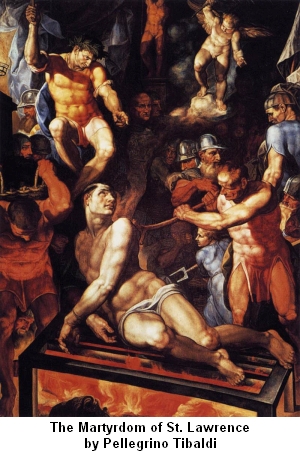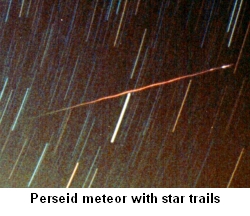¡SkyCaramba! Weekly astronomy blog for the week ending August 8, 2015
 On or about August 10, 258, after a Roman government order to kill all of the Catholic Church’s leaders, the authorities roasted Laurentius, Deacon of Rome, alive on a gridiron. Many Christians still recognize his martyrdom on the anniversary as St. Lawrence Day or with the Feast of St. Lawrence. By coincidence, Earth passes through a meteor stream left behind by Comet Swift-Tuttle every year around St. Lawrence Day.
On or about August 10, 258, after a Roman government order to kill all of the Catholic Church’s leaders, the authorities roasted Laurentius, Deacon of Rome, alive on a gridiron. Many Christians still recognize his martyrdom on the anniversary as St. Lawrence Day or with the Feast of St. Lawrence. By coincidence, Earth passes through a meteor stream left behind by Comet Swift-Tuttle every year around St. Lawrence Day.
Almost 2,000 years ago, Asian sky watchers noted an increase in the number of meteors in the middle of the month westerners called August. But it doesn’t seem to have been of interest to scientific observers farther west until the 1800s. Astronomers didn’t even think meteors were an astronomical phenomenon. They are called meteors because they were thought to be atmospheric – or meteorological – in origin.
That changed one night in November 1833 when startled North Americans saw more than a thousand meteors per minute! Astronomer Denison Olmsted observed that the meteors all seemed to be spreading out from the constellation Leo. He proposed that they were from a parallel stream of material the earth passed through. Reasoning that the planet should pass through it at the same time every year, he and others began looking for meteor shower reports from past Novembers. They also started making their own yearly observations. The shower from Leo was named the Leonid meteor shower.
Of course, meteors are seen any time of year. Most of them are random. But it stands to reason that if the earth’s atmosphere is catching an abundance of materials in one spot to produce one annual meteor shower, it could just as well be catching extra material at regular times throughout the year to produce more annual showers. In Belgium, a statistician named Adolphe Quetelet began looking into the question of how many meteors one should observe before considering it a shower.
 Quetelet announced in 1836 that one would see eight meteors per hour on a normal night without clouds and without too much light. In his quest to define that normal background noise level, he discovered a second meteor shower occuring in August. But he didn’t make a big deal about that. Unaware of Quetelet’s work, American book store owner Edward Claudius Herrick observed more meteors than usual the night of August 9, 1837. He researched past reports and discovered seven such instances in August of years past going back to 1029. That shower is now called the Perseid meteor shower because the meteors seem to come from the constellation Perseus.
Quetelet announced in 1836 that one would see eight meteors per hour on a normal night without clouds and without too much light. In his quest to define that normal background noise level, he discovered a second meteor shower occuring in August. But he didn’t make a big deal about that. Unaware of Quetelet’s work, American book store owner Edward Claudius Herrick observed more meteors than usual the night of August 9, 1837. He researched past reports and discovered seven such instances in August of years past going back to 1029. That shower is now called the Perseid meteor shower because the meteors seem to come from the constellation Perseus.
That’s how science came to understand that meteor showers are yearly events. But scientists weren’t the first to know. In their research, Olmsted and Herrick discovered folk tales told by some Christians in Europe about something that happens on nights close to the Feast of St. Lawrence. Look up, they said, and you can see the martyr’s teardrops burning as they fall from the heavens.
¡SkyCaramba!